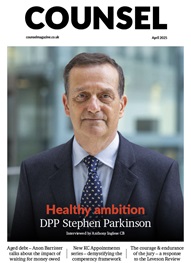*/
Women made up almost half of those recommended for appointment to the Bench last year, but fewer than 10% came from an ethnic minority background, statistics from the Judicial Appointments Commission (JAC) revealed.
Of the 308 recommendations made between 1 April 2015 and 31 March 2016, 140 (45%) were women and only 28 (9%) declared themselves to be from an ethnic minority, while nine (3%) said they had a disability.
Of the of 21 recommendations made for senior posts – above the level of the High Court – only four (19%) were women.
Looking at the recommendations for Recorders – the first rung on the ladder to a full-time judicial career – the Bar Council calculated that white applicants were three times more likely to succeed than candidates from a minority ethnic group.
Sam Mercer, head of equality and diversity at the Bar Council, said: ‘At every stage of the process, BAME [black and minority ethnic] applicants did less well than their white colleagues.
‘If you are a white lawyer applying to become a Recorder you have a one in 10 chance of success. If you belong to a minority ethnic group, that drops to one in 33.’
Mercer said: ‘This inequality is unacceptable. We urgently need to work in partnership with organisations across the legal sector, and with government, to find out why this distortion is occurring and take immediate measures for correction.’
She added: ‘Those appointed as Recorders make up the pool from which the ranks of the senior judiciary are drawn. Lack of diversity at this level has huge implications for the ethnic make-up of our most influential and respected tier of public servants.’
Mercer also noted that since 2012, there have been no BAME applications or appointments at all to the Court of Appeal and there are still no BAME judges in the Supreme Court.
The JAC statistics revealed that the equal merit provision, which has been available for all exercises since July 2015, was used in 14 instances during the reporting period.
The provision means that, in a selection exercise where there are two or more candidates of equal merit, a candidate may be selected for a post for the purpose of increasing judicial diversity.
Women made up almost half of those recommended for appointment to the Bench last year, but fewer than 10% came from an ethnic minority background, statistics from the Judicial Appointments Commission (JAC) revealed.
Of the 308 recommendations made between 1 April 2015 and 31 March 2016, 140 (45%) were women and only 28 (9%) declared themselves to be from an ethnic minority, while nine (3%) said they had a disability.
Of the of 21 recommendations made for senior posts – above the level of the High Court – only four (19%) were women.
Looking at the recommendations for Recorders – the first rung on the ladder to a full-time judicial career – the Bar Council calculated that white applicants were three times more likely to succeed than candidates from a minority ethnic group.
Sam Mercer, head of equality and diversity at the Bar Council, said: ‘At every stage of the process, BAME [black and minority ethnic] applicants did less well than their white colleagues.
‘If you are a white lawyer applying to become a Recorder you have a one in 10 chance of success. If you belong to a minority ethnic group, that drops to one in 33.’
Mercer said: ‘This inequality is unacceptable. We urgently need to work in partnership with organisations across the legal sector, and with government, to find out why this distortion is occurring and take immediate measures for correction.’
She added: ‘Those appointed as Recorders make up the pool from which the ranks of the senior judiciary are drawn. Lack of diversity at this level has huge implications for the ethnic make-up of our most influential and respected tier of public servants.’
Mercer also noted that since 2012, there have been no BAME applications or appointments at all to the Court of Appeal and there are still no BAME judges in the Supreme Court.
The JAC statistics revealed that the equal merit provision, which has been available for all exercises since July 2015, was used in 14 instances during the reporting period.
The provision means that, in a selection exercise where there are two or more candidates of equal merit, a candidate may be selected for a post for the purpose of increasing judicial diversity.


Now is the time to tackle inappropriate behaviour at the Bar as well as extend our reach and collaboration with organisations and individuals at home and abroad
A comparison – Dan Monaghan, Head of DWF Chambers, invites two viewpoints
And if not, why not? asks Louise Crush of Westgate Wealth Management
Marie Law, Head of Toxicology at AlphaBiolabs, discusses the many benefits of oral fluid drug testing for child welfare and protection matters
To mark International Women’s Day, Louise Crush of Westgate Wealth Management looks at how financial planning can help bridge the gap
Casey Randall of AlphaBiolabs answers some of the most common questions regarding relationship DNA testing for court
Maria Scotland and Niamh Wilkie report from the Bar Council’s 2024 visit to the United Arab Emirates exploring practice development opportunities for the England and Wales family Bar
Marking Neurodiversity Week 2025, an anonymous barrister shares the revelations and emotions from a mid-career diagnosis with a view to encouraging others to find out more
David Wurtzel analyses the outcome of the 2024 silk competition and how it compares with previous years, revealing some striking trends and home truths for the profession
Save for some high-flyers and those who can become commercial arbitrators, it is generally a question of all or nothing but that does not mean moving from hero to zero, says Andrew Hillier